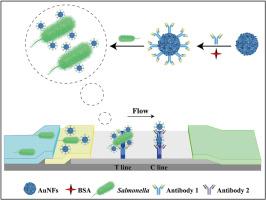A gold nanoflower particle-based immunochromatographic assay sensor for on-site detection of six species of Salmonella in water and food samples
IF 5.7
2区 化学
Q1 CHEMISTRY, ANALYTICAL
引用次数: 0
Abstract
Background
Salmonella is a prevalent zoonotic pathogen that threatens food safety and human health. Owing to the large number of Salmonella species and their significant variations in pathogenicity and virulence, it is difficult to classify Salmonella strains quickly, which makes rapid detection of Salmonella outbreaks and research on foodborne diseases difficult.
Results
Therefore, in this study, an ICA sensor for the detection of multiple Salmonella strains with high pathogenicity based on broad-spectrum Salmonella antibodies was developed using AuNFs as probes. Compared with other Salmonella ICA sensors, the sensor was able to detect six different types of Salmonella. The ICA sensor had a visual LOD of 104 CFU/mL for S. Paratyphi A, S. Typhimurium, S. Paratyphi B, S. Saintpaul, S. Heidelberg and S. enterica. The ICA sensor had no cross-reaction with 20 common foodborne pathogens, which could effectively avoid incorrect results caused by cross-reaction and delay accurate tracing of pathogenic bacteria. Moreover, the feasibility of the ICA sensor was verified by detecting Salmonella in spiked drinking water, orange juice, and milk. The ICA sensor achieved a visual detection limit of 104 CFU/mL and detected as low as 1 CFU/mL in chicken and egg samples after 6–8 h of enrichment.
Significance
In conclusion, this sensor offers a rapid, cost-effective, and reliable solution for the on-site detection of multiple Salmonella strains, addressing critical needs in food safety and public health.


求助全文
约1分钟内获得全文
求助全文
来源期刊

Analytica Chimica Acta
化学-分析化学
CiteScore
10.40
自引率
6.50%
发文量
1081
审稿时长
38 days
期刊介绍:
Analytica Chimica Acta has an open access mirror journal Analytica Chimica Acta: X, sharing the same aims and scope, editorial team, submission system and rigorous peer review.
Analytica Chimica Acta provides a forum for the rapid publication of original research, and critical, comprehensive reviews dealing with all aspects of fundamental and applied modern analytical chemistry. The journal welcomes the submission of research papers which report studies concerning the development of new and significant analytical methodologies. In determining the suitability of submitted articles for publication, particular scrutiny will be placed on the degree of novelty and impact of the research and the extent to which it adds to the existing body of knowledge in analytical chemistry.
 求助内容:
求助内容: 应助结果提醒方式:
应助结果提醒方式:


